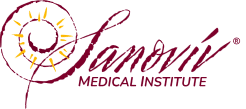October is National Breast Cancer Awareness Month, a time when a myriad of information about breast cancer prevention surrounds you. You may have even participated in a local walk or run event to raise money for breast cancer research. However, you may not be getting the most comprehensive overview of how you can prevent breast cancer and other breast health disorders. Are there essential prevention tips and screenings that conventional breast health awareness lacks? Absolutely! Join us on a journey to a higher level of knowledge when it comes to breast health and learn about the “Sanoviv” approach.
First, you should be aware that National Breast Cancer Awareness Month was founded in 1985 as a partnership between the pharmaceutical division of Imperial Chemical Industries (now part of AstraZeneca, a producer of certain breast cancer drugs) and the American Cancer Society. The purpose has been to promote mammography and ‘early detection’ as an effective way to prevent breast cancer. However, many people ask the question, how does cancer-causing ionizing radiation from mammography prevent cancer? Some organizations, such as Grassroots Health, have challenged this and proposed renaming it to Breast Cancer Prevention Month, emphasizing Vitamin D testing and education. Whatever you call it, breast cancer prevention is important, period.
Iodine: The First Priority for Breast Cancer Prevention
Iodine deficiency may be a reason why one in seven U.S. women has breast cancer. One landmark study that must have been forgotten showed a 200% increased risk of breast cancer in women taking thyroid hormone for more than 15 years compared to those who did not take thyroid hormone. This increased risk is most likely due to iodine deficiency. Since thyroid medication increases the body’s metabolic needs, it also increases its need for iodine. Iodine deficiency in a person who is taking prescribed thyroid hormone will worsen the iodine deficiency problem. In some cases, thyroid hypofunction is not the problem, and medication may not be the correct treatment. Sanoviv recommends iodine testing for people who take thyroid medication. In fact, iodine supplementation may decrease your need and dose of thyroid hormone.
Iodine has documented antioxidant, anti-proliferative, and antimicrobial properties and has shown to be helpful for other breast abnormalities. Low iodine can lead to fibrocystic breasts and breast pain before menses. A randomized, double-blinded, placebo-controlled clinical trial showed a statistically significant improvement (reduction in breast pain and tenderness) in all iodine treatment groups compared to placebo. Treatment groups took 1.5 mg, 3.0 mg, or 6.0 mg of iodine daily, with the most significant improvement occurring in the group that took 6.0 mg daily for five months without adverse effects.
An essential membrane-bound glycoprotein called the Sodium-Iodide Symporter (NIS) transports iodine into the follicular cells of the thyroid and other tissues, including the breast. The NIS is in many different tissues, disproving the previously held view that it is a thyroid-specific protein. All tissues need iodine! However, perchlorate in fertilizers, pesticides, and household bleach, entirely inhibits the NIS, worsening iodine deficiency.
Remove Iodine-Depleting Toxins: The Next Priority
Specific toxins in our environment deplete iodine from the body. This could also explain the increase in breast cancer, widespread hypothyroidism, and iodine deficiency. Bromine, chlorine, and fluoride are widely distributed in our environment, and thus, reducing these toxins is an essential key to optimal breast and overall health.
Bromine
Bromine is found in fire retardants used in mattresses, carpets, upholstery, furniture, and electronic equipment. It is often used in hot tubs instead of chlorine (which is also toxic). Many people are unaware that it is found in some medications, such as Atrovent inhalers and nasal sprays, ulcer medications, and anesthesia. All bakery products that use white flour contain bromine and brominated vegetable oil (Mountain Dew, Gatorade, and other flavored soft drinks).
Chlorine
Chlorine is found in public drinking water/tap water, Splenda (sucralose), hot tubs, propellants in spray cans, bleach, cleaning products, and swimming pools (it’s exceptionally high in indoor pools). Today, nearly 85 percent of all medications, including over-the-counter drugs, contain or are manufactured using chlorine. Some of the more familiar medicines made using chlorine include acetaminophen, Xanax, certain antibiotics, antihistamines, and decongestants.
Fluoride
Fluoride is also found in several medications, such as Flonase, Paxil, Prozac, and other SSRI antidepressants, and fluoroquinolone antibiotics (Cipro, Levaquin). It is also in most public water supplies and is still used in dental treatments. Most toothpaste contains fluoride.
Other endocrine disruptors include bisphenol-A (BPA), dioxin, atrazine, phthalates, perchlorate, organophosphate pesticides, perfluorinated chemicals (PFOA found in non-stick pans and water-resistant products), glycol ethers (paints), fire retardants, and heavy metals (mercury, lead, arsenic). Reduce or eliminate these toxins for optimal health and cancer prevention.
Focus on Key Nutrients for Breast Cancer Prevention
Many nutrients support breast health and play a role in breast cancer prevention. In some cases, dietary sources may not provide adequate amounts.
Iodine
Due to soil depletion and environmental toxins, iodine is generally insufficient in the diet. Sanoviv recommends supplementing iodine with between 1 and 6 milligrams (not micrograms). If you require higher doses, work with an iodine-knowledgeable practitioner. With iodine supplementation, always begin slowly and increase gradually since iodine detoxifies bromine, which can cause some reactions (headache, itchy skin or rash, digestive problems). To prevent bromine detox reactions, include plenty of unrefined sea salt in your diet, along with vitamin C.
Selenium
Selenium deficiency paired with iodine deficiency can lead to hypothyroidism and impaired brain function. Selenium also helps to detoxify bromine. Be sure to get at least 200 micrograms daily or add Brazil nuts to your diet since they are an excellent source of selenium (50 micrograms per nut). However, selenium can be toxic in higher amounts, so avoid taking too much of it from supplements or food. The safe upper limit is 400 micrograms per day.
Vitamin D
Vitamin D is one of the most potent anti-cancer substances, and deficiency is still widespread. Know your blood level of 25-hydroxy D3. Vitamin D is often inadequate in the diet unless you regularly eat liver. We obtain most of our vitamin D from sunlight (unless your cholesterol is too low). Still, since many people avoid sun exposure, taking supplemental vitamin D is probably necessary. Sanoviv recommends 4,000 – 5,000 IU daily from all sources.
Indole-3 Carbinol (I3C)
Indole-3 Carbinol (I3C) and its metabolite Diindolylmethane (DIM) are vital breast-health-supporting nutrients. These nutrients are in cruciferous vegetables such as broccoli, cauliflower, Brussels sprouts, cabbage, and kale. You may want to consider a DIM supplement if you do not eat cruciferous vegetables. Work with a knowledgeable practitioner to determine the appropriate supplement dose.
Iodine Testing: Helpful but Still Not Perfect
There are currently a few tests available for iodine. ZRT Labs offers a valuable urinary iodine test (www.zrtlab.com). Their Elements Urine Test also measures bromine, selenium, arsenic, cadmium, and mercury. Doctor’s Data (www.doctorsdata.com) offers a Urine Iodine pre- and Post-Load (50 mg iodine load), which measures bromine, fluoride, and iodine.
Functional Screening Tests: An Important Part of Breast Cancer Prevention
A recent article in the Journal of the American Medical Association reviewed the scientific evidence about screening mammograms. The authors highlighted both benefits and risks of mammography after reviewing studies from 1960-2014. The review showed a 99% failure rate in women 39-49 years old, meaning 1904 women need to be screened to prevent one breast cancer death.
Other screening methods are less toxic and less invasive. Sanoviv recommends breast thermography and ultrasound and includes these as part of the standard Integrative Physical. Thermography looks at the physiology, and ultrasound looks at the structural components of the breast. Breast thermography is a non-invasive test of breast physiology that can indicate early-stage breast disease. It uses digital infrared thermal imaging. One of the main benefits, besides not exposing breast tissue to ionizing radiation, is that it offers an opportunity for earlier detection when compared with breast self-examination or mammography. Thermography detects physiologic changes that may occur with any breast pathology, such as fibrocystic disease, infections, or vascular disease. Supplements, diet, and lifestyle can help modify early breast changes.
Sanoviv follows the American College of Clinical Thermology (ACCT) recommendations for breast screening. It is also vital to know your background and medical history. ACCT screening guidelines are as follows:
- Annual breast thermography screening for women of all ages
- Mammography, when considered appropriate, for women aged 50 or older
- A regular breast examination by a health professional
- Monthly breast self-examination
- Personal awareness for changes in the breasts
- Readiness to discuss quickly any such changes with a doctor
Lifestyle Factors for Breast Cancer Prevention
Lifestyle changes are essential for the prevention of breast cancer. Diet, sleep, physical activity, stress, smoking, and alcohol consumption have shown an association with breast cancer. Sanoviv offers additional lifestyle tips for breast cancer prevention:
- Eat a whole-food diet rich in vegetables, fruits, and lean proteins, and reduce your consumption of processed foods, caffeine, sugar, and alcohol.
- Exercise regularly but not obsessively. Physical activity helps stimulate the lymphatic and immune systems. Consider exercise on a mini-trampoline (rebounding) as a great way to improve lymphatic circulation.
- Maintain a healthy body weight.
- Get good, restful sleep daily.
- Manage stress effectively and maintain a healthy attitude and positive outlook on life. Negative emotions have been associated with cancer formation and clinical outcomes.
- Laugh often. Laughter boosts the immune system.
- Take time off from tight bras, which restrict lymphatic blood flow and can increase risk. Consider daily dry skin brushing (especially under the arms near lymph nodes).
- Work with a practitioner to learn specific types of breast massage.
Sanoviv Treatments for Cancer Prevention or Treatment
- High-dose Iodine Therapy
- Topical Iodine (for breasts)
- IV vitamin C & other nutrient IVs
- Immunotherapy
- Regional Hyperthermia
- Whole-Body Hyperthermia
- Detoxification Therapies
- Colon Hydrotherapy
- Diet Therapy
- Hyperbaric Oxygen
- Ozone Therapy
- Tumor vaccines
- Hormone Therapies
- Bioenergetic Therapies
- Body Code™
- Psychology Therapies
Consider a Sanoviv program for a comprehensive assessment and specific approach to the prevention of breast cancer and other chronic diseases.

